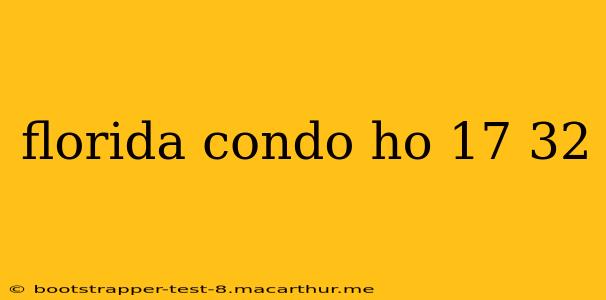Understanding Florida Condo HO-6, HO-17, and HO-32 Insurance Policies
Navigating the world of Florida condo insurance can be confusing, especially with the various policy types available. This guide clarifies the differences between HO-6, HO-17, and HO-32 policies, helping you choose the right coverage for your condo unit. Florida's unique climate and high property values necessitate careful consideration when selecting insurance. Understanding your coverage is crucial to protect your investment and financial security.
What is an HO-6 Condo Insurance Policy?
The HO-6 policy, often called a "condominium unit owners' policy," is the most common type of insurance for condo owners in Florida. This policy primarily covers the interior of your unit, including walls, floors, ceilings, and fixtures. It also typically covers personal belongings within the unit. Importantly, it does not cover the building's exterior structure, common areas, or other shared amenities. That responsibility usually falls to the condo association's master policy. Therefore, understanding what your association's master policy covers is crucial to avoid gaps in your protection.
What is an HO-17 Condo Insurance Policy?
The HO-17 policy is less common and can have variations in its coverage depending on the insurer and specific policy details. It’s generally designed for situations where the condo association’s master policy provides more extensive coverage than a standard HO-6 policy. The HO-17 might cover some structural elements within your unit that an HO-6 might exclude or offer different liability limits. You'll need to carefully review the specific coverage details to understand what is, and is not, included. It's crucial to compare this policy to your condo association's master policy to determine if there is unnecessary duplication or if critical coverage is missing.
What is an HO-32 Condo Insurance Policy?
An HO-32 policy is not a standard condo insurance policy type commonly used in Florida. The naming convention suggests it might be a specialized or older policy or possibly a variation used by specific insurers. It's highly recommended that if you encounter an HO-32 policy, you thoroughly review the policy documents with a qualified insurance professional to understand its exact coverage limitations and inclusions. Don't rely solely on the policy number for understanding the coverage.
What are the differences between HO-6, HO-17, and HO-32?
The primary differences lie in the extent of coverage offered. HO-6 offers standard coverage for the interior of your unit and personal belongings. HO-17 provides a modified or potentially more extensive level of coverage, often bridging the gap between HO-6 and what the condo association’s master policy covers. HO-32 is a less common or specialized policy requiring careful examination to decipher its actual coverage. Ultimately, the best way to understand the differences is to compare specific policy documents.
Which condo insurance policy is right for me?
The best policy for you depends on the specifics of your condo association's master insurance policy and your personal needs. Review your association's documents to clearly define what they cover. Then, discuss your options with a qualified insurance agent familiar with Florida condo insurance. They can help you determine the appropriate level of coverage to adequately protect your investment and personal belongings.
How much does condo insurance cost in Florida?
The cost of condo insurance in Florida varies significantly depending on factors like the location of your condo, the building's age and condition, the coverage limits you select, and your individual claims history. Coastal properties typically command higher premiums due to the increased risk of hurricane damage.
What does condo insurance cover in Florida?
The coverage provided depends on the policy type. HO-6 generally covers the interior of your unit and personal belongings. HO-17 might offer broader coverage, depending on the policy. Always refer to the specific policy documents for a complete list of what's covered. Remember that Florida requires specific types of insurance for condos due to hurricane risk and other potential hazards.
What is the difference between a condo association's master policy and an individual condo owner's policy?
The condo association's master policy covers the building's common areas, exterior structures, and shared amenities. Your individual condo owner's policy (like an HO-6) protects the interior of your unit and your personal belongings. It's vital that both policies are in place to ensure comprehensive coverage. Gaps in coverage can leave you financially vulnerable in the event of a loss.
This information is intended for general knowledge and does not constitute financial or legal advice. Always consult with a qualified insurance professional for personalized guidance.
